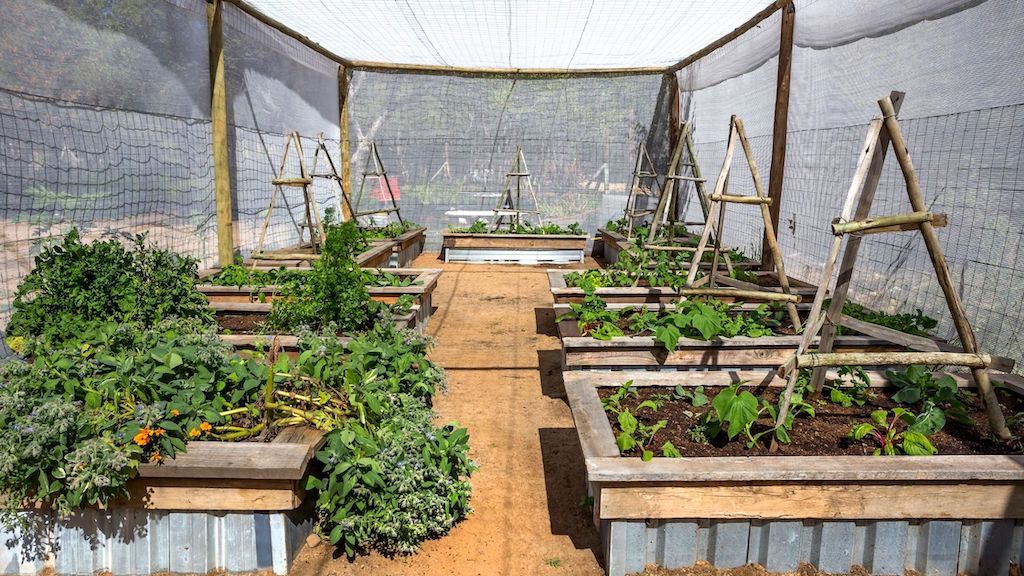Raised bed greenhouses are a great addition to any backyard or balcony. Not only do they look great, but they are highly effective at protecting plants, vegetables, and herbs. Let’s learn more about raised bed greenhouses and why you should install one.
*This post contains compensated links. Find more info in my DISCLAIMER. As an Amazon Associate, I earn from qualifying purchases.
What Is A Raised Bed Greenhouse?
A raised bed greenhouse is a combination of a compact design raised bed and a greenhouse. The greenhouse consists of a raised garden bed with a translucent fabric cover attached to the garden bed. Raised greenhouses combine the advantages of both garden beds and greenhouses.
You fill a garden bed with loose soil ready for planting and cover it with a greenhouse cloth. This kind of structure provides the right environment for your plants to grow more efficiently.
Cool-weather crops such as broccoli, cabbage, and cauliflower are best to grow in a raised greenhouse at the start of spring. These plants’ seedlings grow will still safely in much colder evenings. After the freezing temperatures pass, you can plant warm-weather crops like tomatoes, peppers, and cucumbers.
Raised Bed Greenhouse vs. Raised Bed Cover
Greenhouses allow you to squeeze more growing time out of a year. However, they take up more precious gardening space and money. But you can build a greenhouse right on top of your raised bed or have a raised bed with a cover. But what is the difference between a raised bed greenhouse and a raised bed cover?
The main difference is the material used to protect the plants. A raised greenhouse with beds uses thick plastic or grass, while a raised bed cover uses fabric. However, both safeguard your plants and let you extend your growing season while saving on space.
A greenhouse with raised beds offers the benefits of a traditional greenhouse, such as the ability to control the environment. It helps keep the heat in, providing the optimal temperature for plant growth.
A raised garden box greenhouse is made with a solid covering such as thick plastic or glass. In addition to protecting your plants from pests, a planter box greenhouse keeps the heat in, thus warming the soil.
Gardeners are protective of their plants, and these plants need protection, especially when we take them out of their natural habitats. Our raised bed gardens face pests, frost, wind, rain, and diseases, which can damage our plants. That is why we have raised bed covers to help us protect our plants from some of these elements.
Though raised bed covers are fantastic, they don’t provide for the plants in all the ways a raised bed greenhouse does.
A raised bed greenhouse cover is often made of fabric material with mesh, chicken wire, or aeration holes. Though it may keep pests away, it does not hold the heat in.
Types Of Raised Bed Greenhouses
There are numerous variations in how raised bed greenhouses are built, but they fall under two main basic structures: cold frames and hoop houses.
Hoop Houses
Hoop houses are a cheaper and temporary option. They are a quick DIY project that you can easily set up and take down. Hoop houses consist of rounded frames that hold up some kind of solid cover, typically a thick plastic.
This type of raised garden box greenhouse is usually set up when needed. Since hoop houses are temporary, they rarely have easy-access openings for aeration or hinges.
Hoop house greenhouses should be made of material that is easy to bend into shape. Thin PVC pipes are the most preferred choice because of their ease of use and flexibility. You can also use hoop house kits, hula hoops, or thick wire. Furthermore, the cover should be durable, flexible, and clear.
There are various ways of assembling a hoop house on a raised bed or hot bed garden. The easiest is to stick the hoop’s end in the soil and cover them. If you have wooden planter boxes, you can nail the hoops to their exterior.
Cold Frames
Cold frames are fancier raised bed greenhouses that need a fat wallet and woodwork skills. They are attached to raised beds, mostly on hinges, forming a permanent part of the garden. Since they are used all year round, they should be easy to open. In addition, they are aesthetically attractive with a neat box design.
This raised bed greenhouse has a wooden frame with high-quality glass or plastic. You can easily build a cold frame greenhouse from repurposed windows from home renovations.
Why Have A Raised Bed Greenhouse?
There are plenty of advantages of raised garden bed greenhouses. These advantages include:
Organization
Raised bed greenhouses will allow you to organize your plants better. Greenhouses can get messy with plants, growing trays, and pots all over the place. Planter box greenhouses will enable you to grow similar plants in a single garden bed. You can have an herbs-raised bed, a vegetables-raised bed, and a fruits-raised bed.
Better Drainage
Raised garden bed greenhouses will help in draining your soil off excess water. Gravity will do the work for you. The more elevated the garden bed is, the better the drainage. Overwatering can damage your plants, especially when using growing pots which can accumulate water. Raised bed greenhouses reduce the risk of overwatering.
Deter Pests
One of the greatest benefits of greenhouses is that they prevent pests from attacking your crops. By growing your crops in a raised greenhouse, pests and bugs have less chance of attacking your plants. Pests can still invade growing trays and pots on the ground.

Comfort When Gardening
Gardening can hurt your back because of the bending over. It may also hurt your knees. However, this does not mean that you give up on farming. A raised bed greenhouse will solve the problem.
Year Round Growing
Raised bed greenhouses increase your growing season. A raised bed hoop house is ideal for growing plants in the winter season. It will be able to provide warm temperatures for your plants. Hoop houses provide excellent insulation during colder days.
Increased Location Options
Raised bed greenhouses are easier to install in any space and are portable. The elevated garden bed allows you to grow your plants in rocky areas and areas with huge tree trunks.
Protection From Weather
With a raised garden bed greenhouse, you don’t have to worry about the repercussions of unpredictable weather.
Best Raised Bed Greenhouses For Home
Now that we know the various advantages of raised garden bed greenhouses let us look at some of the best available options.
Canditree Wooden Raised Garden Bed And Greenhouse

This raised garden bed is made of wood, making it resistant to unpredictable weather changes. The top greenhouse offers protection and warmth to the plants. This greenhouse is well designed. It will offer a touch of natural charm to your living space. The Canditree wooden raised garden bed is large and offers ample space for plants to grow in. The garden bed is beautiful when plants are growing and is an eye-catching addition to our backyard.
Raised Cedar Greenhouse
This greenhouse is a raised mini greenhouse with a lift-open roof that makes it easy to manage. The greenhouse features a roomy rectangular garden bed and a lift-up lid with four windows. This raised greenhouse offers protection to your plants. You can use the lower shelf to store gardening equipment. Solid wood from Cypress tree makes this raised bed greenhouse durable. The medium brown color blends well with the natural settings and other decors.
Stand-Up Garden Greenhouse System
This greenhouse is perfect for the spring planting season. However, you will be able to use it through the harvest time into the frost fall season. The stand-up style is easy on your knees and back. The comfortable height gives you a lovely planting and gardening experience. The height also keeps pests at bay. The greenhouse cover is clear and beautiful. You will have full frontal access to your plants and side vents for aeration. A powder-coated sturdy steel frame makes it sturdy.
Tips To Make The Most Of Raised Bed Greenhouses.
The following tips will help you get the most of raised greenhouses.
- Pick a good location. Ensure that your raised bed greenhouse is in a space that receives adequate sunlight. The greenhouse enclosure should trap enough heat during the day.
- Plant a suitable number of plants. Ensure that you do not crowd your raised bed greenhouse. Plants need ample space for their roots to grow and get sufficient nutrients. If the plants are overcrowded, they will compete for nutrients and space.
- Practice companion planting. Choosing plants that complement each other will help you maximize your space.
- Choose the correct type of plants. A lot of plants can grow in a raised bed greenhouse. However, it would be best if you choose plants that benefit from the conditions of a raised greenhouse. Herbs are among the best plants.
Raised bed greenhouses are ideal for growing several plants. If you are afraid that drastic weather changes will affect your plants, then raised greenhouses are the way to go.
FAQs – Raised Bed Greenhouses
Raised beds work well both inside and out of a greenhouse. Their design is not dependent on where they are placed, allowing them to be used successfully in a greenhouse.
The general rule of thumb for a raised bed should have a depth of 9-12 inches. This depth allows sufficient room for plant roots to flourish.
